The Complete Story: What Really Happened in Iowa
10 2020

You’d be forgiven for feeling like Bill Murray in Groundhog Day right now. Not only is it early February, but it probably feels as if you lived through the 2016 primary, went to sleep for several years, and then woke up right back at the beginning of 2016.
As happened so many times during that primary, this past week a small state held an election that should have been efficient, clean, and fair, with a minimum of fuss and mistakes, but instead turned into a godawful “debacle” full of “irregularities” that mostly harmed the chances of one candidate, Bernie Sanders. And just like in that 2016 primary, some watchers of this new 2020 primary see that “debacle” as the result of incompetence, others see mere coincidences, and others see outright conspiracy and fraud.
What everyone agrees on is that this was a disaster for democracy that should never happen again.
Let’s break down this very first election of 2020 so we can determine whether it is fundamentally a conspiracy, gross incompetence, or coincidences that are to blame. We’ll begin with a list of everything we know, in chronological order. If you’re in a hurry, you can scroll down to the heading “Coincidence, Incompetence, or Conspiracy?” for my conclusions.
A Timeline of the Things We Know
2019
Spring 2019. The DNC and party upper establishment indicate for months that they would strongly prefer Bernie Sanders not be the nominee. (source, source)
Summer 2019. The Pete Buttigieg campaign participates in at least one of several “Stop Bernie” private meetings in the spring and summer of 2019. The Biden, Warren, and Klobuchar campaigns do not appear to participate in these meetings. (source, source)
Summer 2019. Shortly thereafter, the Buttigieg campaign gives $42,000 to Shadow, a small software application firm launched by a DNC-connected company called Acronym. At this time the Iowa Democratic Party (host of the country’s first caucus) and the Nevada Democratic Party (host of the country’s second caucus) also provide funds to Shadow for the purpose of developing an app to intermediate counting of caucus results. The Shadow app was thereafter developed in preparation for use in the Iowa caucus. The Biden campaign contributed a smaller amount ($1,200) to Shadow; the Sanders, Warren, and Klobuchar campaigns did not contribute at all. (source)
2020
January 2020. Shortly into the new year, Bernie Sanders surges out of ties for second and third place and into first-place ties or outright leads in polls of both of the first two states to vote — Iowa, a caucus state, and New Hampshire, a primary state. Of particular note is his jump into a solid lead in the Des Moines Register poll — considered the “gold standard” of Iowa caucus polls because predicting the caucus’s arcane alignment system is notoriously difficult and because this poll has correctly picked the winner on the Democratic side every time for three solid decades.(source, source, source)
January 2020. Many of the top establishment DNC centrists — the Clintons, Barack Obama, John Kerry, etc. — express fear publicly that Sanders could win the nomination. This despite nine months of attempts by them in the media to “Stop Bernie.” (source, source)
January 2020. At the end of January, Bernie Sanders’ lead in New Hampshire widens to double digits in some polls. Any candidate in the last 40 years — in either party — who has won both Iowa and New Hampshire has gone on to win their party’s nomination. Stopping Bernie in Iowa could thus be seen as the last chance to possibly get out ahead of a certain Sanders nomination. (source, source)
February 1. Iowa Caucus day approaches and Bernie Sanders is leading in Iowa polls — and rising. Observers are increasingly predicting a solid Sanders win. (source, source, source, source)
February 2. On the eve of the caucus, for the first time in 76 years, the “gold standard” poll by the Des Moines Register is abruptly cancelled. This is done based on an unproven assertion by a Pete Buttigieg supporter that Pete was left out of questions when a pollster called. Cancelling the entire poll like this reduces both Bernie’s momentum and the growing sense of a likely victory. The poll’s results are leaked, however, and show Sanders has not only maintained but extended his lead, to 22%, while Biden has dropped all the way down to 4th place, at 13%. The poll is not covered by mainstream news. Buttigieg enters the caucus trailing Sanders by some 7% in the RealClearPolitics average of the latest polls, and by 6% in this poll. (source, source, source, source, source, source)
Caucus Day, February 3.
[Around 9:45pm CDT] Caucus day arrives with much fanfare, and as evening comes, one by one the caucuses close their doors and record their support. The very first 1.7% of caucus sites report results. In a major surprise, Pete Buttigieg jumps out to a lead, 27.6% to 26.4%, over Bernie Sanders.
[9:58 pm] About ten minutes later, a tiny additional slice of results comes in, and with 1.8% of caucus sites reporting, the numbers flip, and Bernie is winning with 28.3% of the vote; Buttigieg drops to 23.9%.
[10:10 pm] At this point, for some unspecified reason, the release of results is cancelled altogether. No further official results come in for the rest of the night. (source)
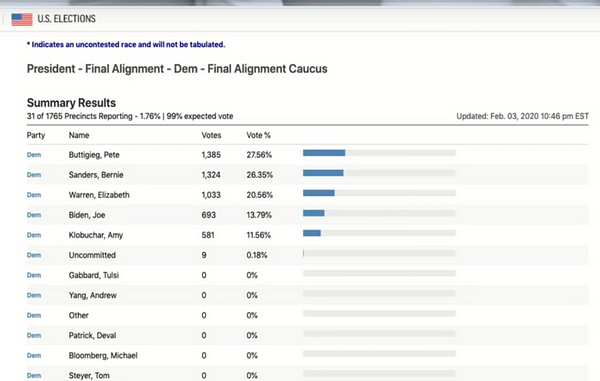

[10:20 pm] In the confusion over the halt of the results, news surfaces that a phone app that most people have never heard of has been used all night to report final numbers to the IDP. People all over the country learn for the first time about a little-known company named Shadow, its ties to Acronym and Hillary for America 2016, and that for the first time caucus results are being reported to the IDP via software that has the ability to adjust numbers prior to final tabulation. Glitches with the Shadow app occurring after caucus numbers are entered but before confirmation is displayed on the app have forced nearly every precinct to call in the results by telephone. (source, source)
[11:05 pm] On social media, campaign staff for Pete Buttigieg publicly post PINs for logging into the Shadow app, thereby potentially allowing anyone on its social media channels to adjust caucus totals. (source, source)

[11:20 pm] With no further reports of results, no exit polls, less than 2% of precincts reporting, and with Sanders slightly ahead in the last batch of results, Pete Buttigieg inexplicably gives a victory speech. “Iowa you have shocked the nation… we’re heading to New Hampshire victorious.” It appears to all the world he knows something the rest of us don’t. (source, source)
[11:25pm] Staffers from the Sanders, Warren, and Klobuchar campaigns all report “difficulties” submitting results and “inconsistencies” in the numbers appearing in the Shadow app that are not the numbers they’d reported from their caucuses. (source, source, source)
[11:35 pm] News surfaces in social media that unbeknownst to the DNC the Bernie Sanders campaign has been—in addition to reporting caucus turnout and alignment numbers via the Shadow app—recording all numbers in an app of their own that they had made for this purpose. They had done this for real-time visibility into how the campaign was faring, as well as “just in case” there was some need later to verify the results. The prescience of this becomes apparent quite quickly. (source, source, source)
[11:50 pm] Midnight approaches and no further numbers have been released by the IDP. This is bewildering given the fact that it’s a caucus and there are no ballots to count. There are just caucus numbers to add and release. Nate Cohn of the New York Times calls the delay abnormal and notes, “by this time in 2016, nearly 80% of the total vote was counted.” The explanation eventually given is that there are reporting errors in the Shadow app, but suspicions grow that count manipulation may in fact be occurring. (source, source)
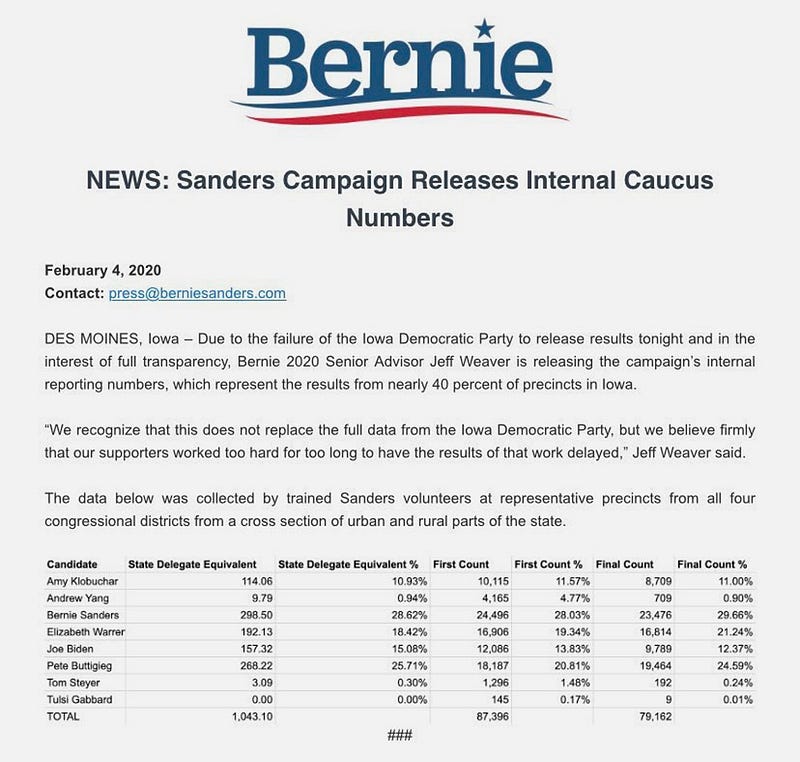
[12:15 am] Just after midnight, with the complete absence of reported results, a fear of count manipulation, and the unexpected Buttigieg victory speech, the Sanders campaign releases data from their own app. Unlike the Shadow app, their app has evidently functioned well. They release data for fully 40% of caucus sites. The numbers show Sanders winning the state by a comfortable margin — by 8% in the initial popular vote and by 5.1% after caucus realignment, consistent with recent polling in the state, including the leaked “gold standard” Des Moines Register poll. The Sanders campaign’s numbers also show a lead for Sanders in the count of SDEs: 2.9%. The count of SDEs is much tighter because of the change in IDP rules made for 2020, weighing rural districts’ caucuses more heavily than college and urban districts’ caucuses. (source)
It appears possible at this point that the ingenuity and thoroughness of the Sanders campaign’s app have averted, at best, a catastrophic failure by the IDP’s new software, and at worst an actual attempt to steal the Iowa Caucus.
[1:05 am] The Iowa Democratic Party announces that they need more time to compile the numbers and will report results “some time tomorrow.” (source)
Tuesday, February 4
- The world wakes up to headlines about an “Iowa Debacle.” There is no reported winner, but many outlets mention Buttigieg’s name first in the headlines and use imagery of Buttigieg to suggest a victory for him. A smaller number of outlets include the Sanders campaign’s numbers, since they’re the only numbers available in any quantity, and suggest instead a likely Sanders win. (source, source, source)
- The IDP announces that they need more time. They promise to release “a majority of the results” from the Shadow app’s reports, “by 5pm EST.” And late that afternoon, the IDP does indeed release their first numbers, kicking off what will become an excruciating, trickling release of data that will go on for two full days. They release data for 62% of the precincts, presumably collated from Shadow app data, which they now say “has not been corrupted.” The numbers that are released are quite different from those released late the night before by the Sanders campaign. The numbers show Buttigieg, not Sanders, winning in the SDEs count, and Buttigieg losing much more narrowly to Sanders in both the popular vote and support after caucus realignment. (source, source)
- There is no explanation for why the counting takes so long when there are no ballots to count, all the data is supposedly there, and the data is not corrupted. Nor does the IDP explain why they choose to release which precincts first and why they don’t just release all precincts’ data at once.
- Suspicions of vote manipulation grow; there is something eerily reminiscent of rigged elections in Central America where the release of numbers is halted on the evening of the election when one candidate pulls ahead, and then the next morning when final numbers are released, another candidate has won. (source)
- The IDP releases a small additional batch of results, bringing the reporting precincts up to 71%, and with this and each subsequent trickle, new media stories appear lauding Buttigieg’s success. Buttigieg also sees a startling 9% bump in his polling numbers in New Hampshire later in the evening.
- At this point, the DNC announces they are “taking over” the counting from the IDP. This has never occurred before according to Iowa officials. If the job is simply to report numbers it is unclear what exactly the IDP could be doing wrong, although there is a widespread call for the numbers to be released more quickly. (source, source)
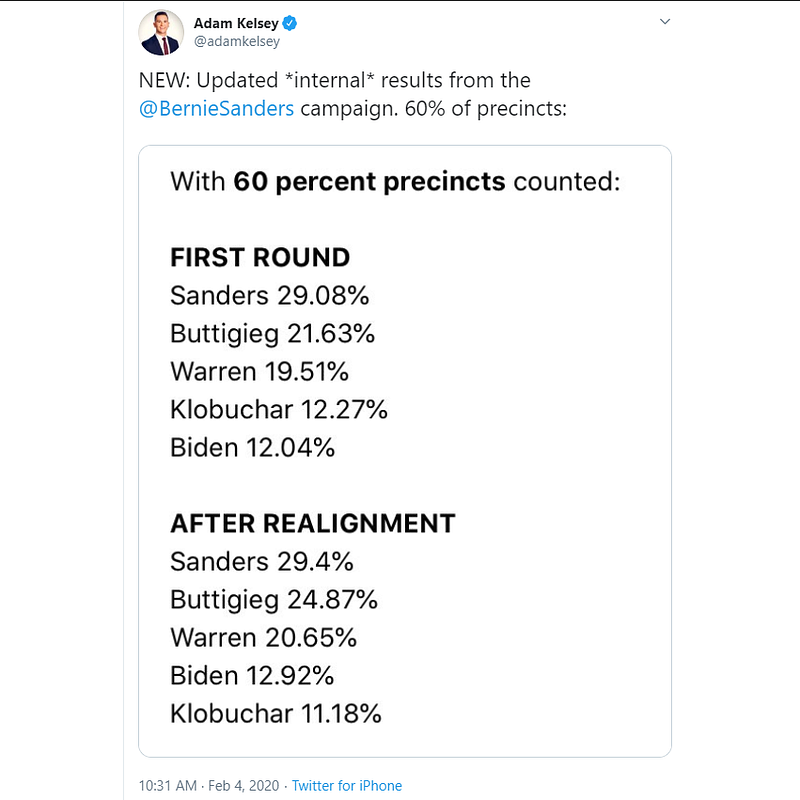
The Sanders Campaign releases another 20% of the precinct data from their app. This brings to 60% the portion of precincts they’ve reported. The data shows Sanders maintaining a consistent 8% lead in the popular vote and a 4-5% lead after realignment. Why both camps — the DNC and the Sanders campaign — don’t just release all their numbers at once is a point of confusion and speculation. One theory is that it’s a game of chicken, both waiting to see what the other has. Another theory is that the Sanders Campaign is withholding their numbers as insurance to prevent chicanery. (source)
Errors in the DNC’s numbers begin to surface on social media as people point out variances between publicly available caucus numbers and the results the DNC is reporting. In Black Hawk County, for instance, local county supervisor Chris Schwartz tweets out his frustration that the numbers aren’t being reported in a timely manner from precincts where Bernie Sanders did well — and that the numbers that are reported appear manipulated. In this case votes have apparently been shifted from Sanders (and Warren) to barely-running candidates Tom Steyer and Deval Patrick. (source, source, source)
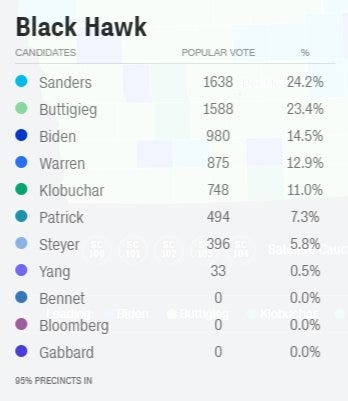

An important point made by Sanders surrogates and media commentators is that the importance of the Iowa Caucus is not its small haul of delegates (41) but rather the momentum the first win in a long primary provides in terms of media buzz and fundraising. Thus, the way the DNC delays and stretches out the count on the day after the caucus delivers essentially the entire goal of the Iowa primary to Pete Buttigieg: He gets the momentum and media coverage of a winner before anyone knows who won. (source, source)
Wednesday, February 5
- More numbers from the DNC count trickle out Wednesday morning. 75% of precincts are now included, and Bernie begins catching up to Buttigieg in the SDEs. Sanders also remains ahead in the popular vote. (The count of SDEs isn’t used for anything other than determining the number of Iowans from each campaign who get to go to the Iowa Democratic Convention, but this is the number the media goes with rather than popular vote or support after caucus realignment, and it’s the number Buttigieg leads.)
- Suddenly the latest DNC results are revoked and revised. Things are amiss with the numbers, they announce. Over 100 inconsistencies in the data are found, everywhere, even by establishment media sources like CNBC and the New York Times. Much as on election night, it appears that when Sanders begins doing well, the reporting is halted. (source, source)
- More evidence of tampering appears on social media, including instances of delegates earned by Sanders given outright to other candidates. In addition to Black Hawk County, above, James Payne, a precinct worker in Polk County, also reports seeing this. (source, source, source, source)
- CBS News reports on an investigation of the source code of the Shadow app by CNET who discovered that the app sends data about reported results out to unknown IP addresses, notifying unknown third parties in real time about reported results. (source)
- The trickle of data continues, 85%… 89%…, and then shortly before midnight Wednesday night, after the day’s full media cycle is over, the numbers jumps to 97% and show a big gain for Bernie Sanders. Precincts where Sanders did well, including Black Hawk and Polk counties, which had been held back for some reason, are finally released, and Bernie pulls not only farther ahead in the popular vote, but Sanders and Buttigieg are also now virtually tied in the SDEs count: Buttigieg clings to a tiny lead of 550–547, or 0.2%. (source)
Thursday, February 6
[7:00 am] The nation wakes up to this virtual tie in SDEs and to a clear Sanders victory in the popular vote. 3% of the vote remains to be counted, and the Sanders campaign expresses confidence they’ll pull ahead when the last precincts come in.

[10:25 am] At this point, with just 3% of the vote is remaining, DNC Chair Tom Perez cancels the reporting of results. “Enough is enough,” he says, declaring there have been too many inconsistencies and the IDP should “immediately begin a recanvass of the vote.” (source, source)
Meanwhile, stories surface across Iowa about support shifting to Buttigieg in unusual ways. Coin tosses that are obviously unfair. Empty caucus rooms that give wins to Buttigieg. (source, source)
Evidence of other errors in the reported data surface on social media. Not every single error detracts from Sanders, but most seem to, and a detailed, crowdsourced spreadsheet tracking these errors shows that as a whole the errors amount to a net loss of 4.4 earned SDEs for Sanders, which would be enough to give Sanders the victory in this count as well as the popular vote. (source)
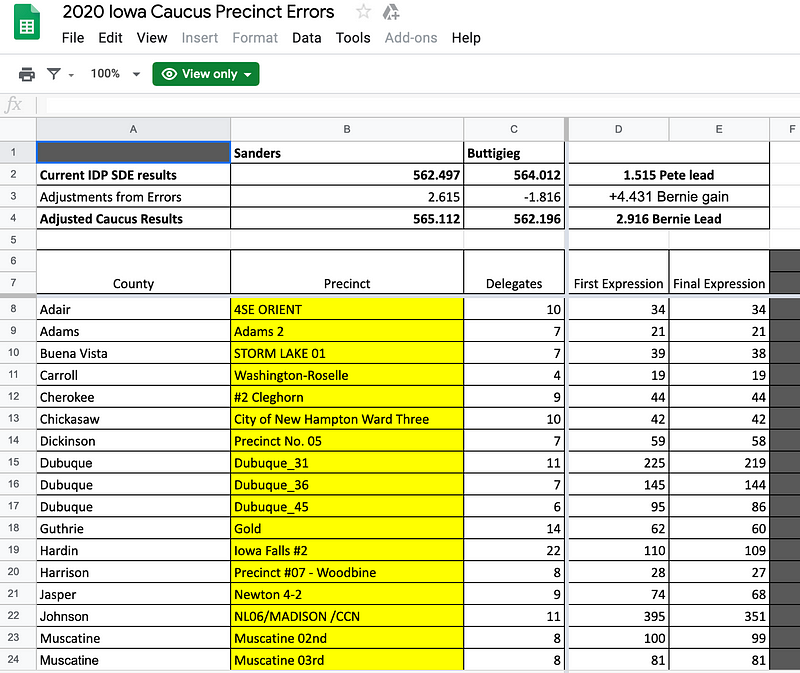
A visualization of the issues and errors neatly depicts exactly who has benefitted from the “irregularities.”
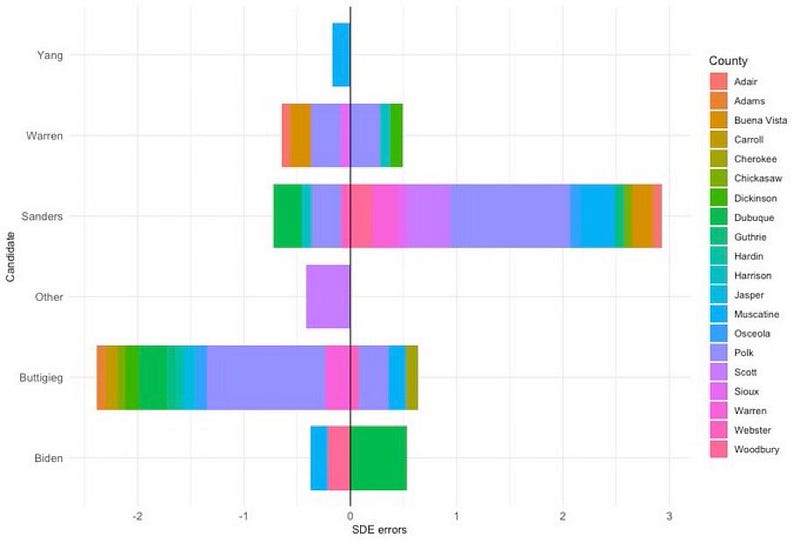
[12:05 pm] With a stable lead of 6,000 votes by the DNC’s count, calling the popular vote a better measure of support than the SDEs count anyway, Sanders declares victory. He releases a video thanking Iowa for the decisive victory in the popular vote, and decrying the slow pace of the release of the DNC’s numbers. When asked repeatedly by media outlets how he can declare victory, he says that where he comes from, the person with the most votes in an election is the winner. (source, source, source)
[8:00 pm] That evening, at the very moment Pete Buttigieg steps onto the stage for a CNN Townhall, where he likely would have been asked about declaring victory prematurely, the DNC releases another trickle of data that brings the number of precincts reporting to 99.4%. And with that, the DNC announces Buttigieg has won the caucus based on its count of the SDEs, where he has a lead of 0.1%. From a media optics perspective the timing is perfect: Buttigieg is literally told that he is the victor of the Iowa Caucus live on CNN and gets to make an impromptu victory speech. It turns out other media outlets aren’t as eager to call the election as CNN — the AP for instance, says there remain “too many inaccuracies” in the results— and the Buttigieg campaign doesn’t quite nail the town hall appearance and is later caught editing video clips to add crowd applause. Nevertheless the appearance is a wonderful coup for the Buttigieg campaign. (source, source, source)
If these results hold it would mean that for the first time since it began following Ann Selzer’s famous method in 1988, the Des Moines Register “gold standard” poll will not have predicted the winner of the Iowa Caucus on the Democratic side. (source)
[11:15 pm] The currently “final” numbers (numerous obvious errors notwithstanding) show Bernie losing by less than one quarter of one percent, just as he did in 2016 in the same state at the same point to Hillary Clinton. What are the chances that an anti-establishment candidate who is nor favored by the DNC loses twice in a row to an establishment candidate by the same razor-thin margin? That we are left to ponder.
And there we have it, the full debacle in slow motion for you to experience again and again, like Bill Murray in Groundhog Day. The alarm clock beeps, it’s a new day, just like the old day, and a primary election catastrophe unfolds. Once again, it ends with a margin of less than a quarter percent.
Coincidence, Incompetence, or Conspiracy?
Nobody disputes that the way this caucus transpired was a catastrophe. Outlets as mainstream as the Washington Post and New York Times have called it an “epic fiasco” and a “tech disaster.” It was a debacle.
The question is, why was this caucus such a catastrophe? Were all of the ridiculous events and disturbingly wrong reports caused by a series of coincidences, or by breathtaking and widespread incompetence, or by a deliberate and concerted effort to help one candidate in this primary at the expense of another?
When attempting to discern the underlying reasons why things descended into chaos and errors, it’s important to consider the events and what’s at stake in their totality. Any one incidence of malfeasance can often be explained by the simple incompetence or dishonesty of a single actor. In this case, the series of events in their totality — and the impact they have had in what has become a burgeoning struggle for power inside the Democratic Party —should force anyone who cares about the truth not only to closely investigate individual events, but to step back and consider the forces at play.
As evidenced by the “Stop Bernie” meetings of 2019 and the many attacks on Bernie by the establishment Left, it is clear that there is a battle today for control of the Democratic Party. This battle erupted onto the political scene with the rise of Bernie Sanders in 2015, but I would suggest it truly sprouted at the end of the previous decade: widespread disappointment with Obama during his first term; the recession, bailouts, and foreclosures that marked 2009 and 2010; and the Occupy Wall Street and radical climate movements that took root at the same time. This party has been cleaving in two, with the “centrists” — or “New Democrats” — on one side, and the “progressives” on the other. The “New Democrats” rose to power with the Democratic Leadership Council and Koch money in the late 1980s: a well-funded, pro-corporate-power, somewhat-socially-liberal political message propelled the Clintons into the White House and onto the top of the mountain in the Democratic world. The “progressives” have been consolidating a mass movement of people disillusioned with the outsourcing of jobs, unfettered capitalism, endless war, corruption, racist criminal justice, environmental destruction, and austerity in the form of falling wages and rising healthcare and housing costs. The hold on the party that the “centrists” have enjoyed for decades has never been more threatened than it is today.
With this in mind, we can assess the causes of the “Iowa Caucus
Debacle 2020” knowing that it was the first battle in the year’s war for control of the party itself.
Coincidence. Let’s first consider coincidence and determine whether the events of this caucus can be explained by improbable happenstance. Taking one unusual event—Bernie Sanders losing by the same less-than-a-quarter-percent margin this year as he did to an establishment candidate in 2016, for instance—you could logically say, “yes, wow, that is really unlikely and very surprising, but it’s just a coincidence.” These numerical collisions happen sometimes.
Let’s dig a little deeper. Could it be also just a coincidence that Buttigieg gave a victory speech with only 1.8% of the precincts reporting and Bernie Sanders actually in the lead? Could it be also just a coincidence that the numbers thereafter were released so slowly — over the course of two days — and that all of the precincts favoring Buttigieg were released first and during prime news cycle hours? Could it be also just a coincidence that when the final numbers were released they dropped literally at the moment Buttigieg stepped on stage for a prime time CNN town hall, providing him an unusually telegenic scene? Could it be also just a coincidence that for the first time in its existence the Des Moines Register “gold standard” poll was canceled on the eve of the caucus? Similarly, could it be just a coincidence that for the first time since Ann Selzer began polling in 1988 that this “gold standard” poll didn’t accurately predict the winner on the Democratic side?
When you have many coincidences of this type — improbable or unprecedented events — and they all favor the same candidate, the rules of probability must assert themselves.
Let’s look a little more deeply at one putative coincidence: the release of the numbers. Even if one assumes that the Shadow app numbers were completely legitimate and fair, and that all the revisions to those numbers were legitimate as well (and I’m not saying that assumption is justified), still, why, one must ask, were the Buttigieg-favoring precincts reported first, one after another, allowing the media to run for a day and a half with an apparent Buttigieg victory, before numbers for the Sanders-favoring precincts came in? And why were the reporting of results canceled three times, all apparently just as Sanders was pulling even or ahead?
Considering them all, in my calculation, there are simply too many highly improbable events favoring one outcome — an outcome favorable to the stated interests of those running the caucus — to wave them all off as mere coincidences.
Incompetence. What about incompetence? Could stupidity, inexperience, and simple misunderstandings explain the catastrophic way this caucus unfolded? The fact that many coin tosses looked rigged — and resulted in more delegates for Buttigieg than for any other candidate — probably just means a handful of people in Iowa didn’t know how to flip a coin fairly in a public setting. The fact that the Shadow app was written so poorly and was rushed through testing so quickly, and that it ran into countless issues, the largest of which prevented submission of photographs of hand-counted caucus results to confirm reported numbers—possibly this could be explained by massive incompetence on the part of the CTO, the engineers, and the product team at Shadow if we can also suppose the CEO was sufficiently asleep at the wheel too. But then we run into a coincidence not mentioned above — that virtually the entire Shadow leadership team are former staffers at Hillary for America 2016, a group of people potentially antagonistic to Sanders. So we have to accept supposed incompetence and coincidence here.
Could it have been simple incompetence that in so many caucus sites, the numbers reported by workers at the caucus didn’t match the numbers reported in the Shadow app? This would be a huge amount of mathematical and stenographical incompetence for a state that by all accounts takes their responsibility as the “first in the nation” very seriously.
Could it have been simple incompetence that the IDP, and then the DNC, simply couldn’t add up the numbers correctly for days on end? Even after taking hours to release tiny portions of the results, they still had to revoke and revise the numbers they’d released. This is a pretty stunning level of mathematical and bookkeeping ineptitude if all they were doing was importing data and performing arithmetic.
Again, if the supposed incompetence benefited both sides roughly equally, this notion of feckless execution might be a compelling explanation for the events. But when the majority of the “mistakes” benefit one side, and it’s the side with both the power and the stated intent to bring about a certain outcome (in this case to “Stop Bernie”), and that outcome is in fact the result of the troubling events, incompetence as a complete explanation doesn’t make sense.
Therefore, based on everything we know right now, neither coincidence nor incompetence appears to sufficiently explain the events of the caucus.
If ruling out coincidence and incompetence here still seems too big a leap, could you be perhaps biased about the particular person or political party in question? Consider a scenario in which all of the facts are identical but instead of Pete Buttigieg it is Donald Trump for whom a poll is canceled, who makes a very early victory speech, who benefits from connections to a shadowy political tech company likely antagonistic to his opponent. What would you say in that scenario?
It is worth noting that things could change. Here are possible future events that could make incompetence and coincidence a more compelling explanation:
- Terminations or resignations at Shadow and Acronym. If the true cause of the failures with the app was atrocious programming and testing, then we should see 2–3 people terminated at Shadow and a similar number at Acronym. Any honest company would release employees responsible for poor work that destroyed the company’s reputation.
- Similar terminations or resignations in the IDP and DNC. Ultimately this is the DNC and IDP’s show to run. If it was just incompetence that resulted in this catastrophe — and they really want to repair their reputation and prevent similar events going forward — there should be terminations for the people who were most responsible.
- Correction by the DNC of the final official results, including all mathematical and reporting errors uncovered by the Sanders campaign, independent journalists, and social media writers. These include the crowdsourced spreadsheet and visualization included above in this article. As in any industry, incompetent work should be addressed thoroughly and the task redone until it is complete and correct.
- Release by the Sanders campaign of their full numbers, and the numbers being similar to — or at least converging towards — the DNC’s reported numbers.
- Exit polls are instituted as a check against fraud in future primaries and caucuses. As I reported time and again in 2016, exit polls in the primary between Bernie Sanders and Hillary Clinton revealed likely fraud until… they were abruptly canceled for remaining primaries, removing a significant check on potential fraud in 2016 primaries. Exit polls should be reinstituted now in 2020 for the sake of trust in the process.
- NOTE: Cancelling future Iowa Caucuses should not be seen in any way to excuse this past caucus. It is another stated aim of the DNC to replace caucuses with primaries, but caucuses are harder to rig than primaries, not easier, since most primaries use unverified voting software that can change votes with even less visibility than we have with caucuses. It’s likely we’d know far less about the inner workings of this Iowa election had it been a primary. Also, progressives historically do better in caucuses, perhaps for this reason.
In summary, when little is at stake, incompetence and coincidences, taken together, can sometimes fully explain unexpected behavior of major institutions. And when coincidences and incompetence affect all parties in roughly equal measure, there is usually little reason to suspect foul play. But when supposedly innocent mistakes affect one side far more than the other, and when tremendous wealth and power is at stake as it is today — control of the Democratic Party, and with it the ability to set the “acceptable left side” of this country’s entire debate on issues — a concerted plan to maintain wealth and power looks less like a vast secret conspiracy and more like wealth and power doing what wealth and power does: ensuring it keeps wealth and power.
Conspiracy. So do we see evidence to suspect that there was a concerted plan behind the scenes to distort the results of this caucus? My fellow Americans, when looking at the totality of the events of the week, and the forces at play, I don’t think anyone with an open mind and the time to review the full sequence of events can come to any other conclusion than this: There’s a prima facie case for election sabotage, vote manipulation, and deliberate deception in the management of public information, and this case should be taken very seriously by all parties who care about our democratic institutions.
In an investigation of a crime — and a crime is what this appears to be — one traditionally looks for means, motive, and opportunity. In this case all three are clearly present:
- Means — the Shadow app, an unnecessary tool inserted into the process provided a method to shut down counting or reporting of caucus election numbers, to send to anonymous IP addresses the reported results before they were released publicly, and even to adjust those numbers prior to final tabulation.
- Motive—an intent to “Stop Bernie” has been openly stated by those in power at the top of the Democratic Party.
- Opportunity — the IDP continuously slowed down the reporting of the votes, down to a crawl, which provided two full days to tweak the numbers. That gave the DNC the opportunity to manipulate the results if they so chose, and they indeed stepped in and “took over” the counting of the vote on the second day.
I don’t suggest that I’ve conclusively proven anything here by putting together this timeline and analysis. I do believe that anyone who cares about the truth will find the explanation that best accounts for all the observed occurrences to be concerted planning behind the scenes. There should be a deeper investigation to uncover more evidence that what I’ve been able to find.
Here’s Krystal Ball, host of The Hill’s popular independent news show Rising, explaining more clearly than I can the clear prima facie case that this caucus was deliberately rigged:
Should We Be Surprised?
If the conclusions above are true, and the caucus was run in a deliberate way to help one candidate at the expense of another, should this news surprise us? It can be difficult for many of us even to contemplate things that the mainstream media doesn’t talk about. Election fraud and rigging are taboo topics in the mainstream media, and the New York Times/NPR/MSNBC media chamber in particular, connected as it is to the “centrist” DNC faction that is currently in power, will generally never give readers any reason to consider ideas that suggest vote tampering, unless the allegation is about a foreign country, such as Russia. Even Facebook has configured its algorithm to suppress articles it doesn’t consider “legitimate” news—including some articles that suggest this Iowa caucus was rigged — so you might have to share this article three times as often as any other piece to draw the same attention to it.
But we should remember that we live in the era after the scandal about WMD in Iraq, when a government and media conspiracy placed fake news before us repeatedly to convince us to invade Iraq, ushering in a disaster that enriched some while killing more than a million people. Late last year, obscured by incessant impeachment coverage, we learned in the Afghanistan Papers about an even larger government and media conspiracy to deceive the public about the Afghanistan war — that we have always been losing, that no Americans there have ever even known who the enemy is, that it was a disaster from the start, and that the way we’ve kill civilians there might be worse than what the Nazis did.
So the notion that government officials might lie to us or even engage in a conspiracy to further their own power probably shouldn’t surprise us. Power corrupts, as it always has, and there is nothing if not power at stake when the reins of the American government are up for grabs.
Ultimately, Bernie Sanders won Iowa — that much is clear now that we’ve delved into the data and examined the number of coincidences and manipulations that had to transpire to make it appear otherwise. What’s not quite as clear is by how much he won in each metric and whether an attempt to steal the caucus was as successful as planned or whether it was partially thwarted by technology glitches and vigilant staffers of the various campaigns; more investigation is necessary.
Going forward, we must be neither paranoid nor naive. Whomever you support, for the sake of eventual party unity — and for our democracy itself — please consider the importance of transparency, and please demand a fair and open inspection of every credible allegation of fraud throughout this primary. We deserve nothing more nor less than a fair counting of the votes at each and every caucus and primary. Exit polls, it should be said, are essential as well and should immediately be reinstated.
You might have felt like it was Groundhog Day when you saw the news reporting that Bernie Sanders had lost Iowa by the same minuscule margin today by which he lost to Hillary Clinton in 2016. How is it possible for things to be so different yet exactly the same? This question deserves genuine contemplation. I believe this loop will continue until we wake up more deeply, see the media and political landscape for what they really are, and join together as a nation of aware individuals to demand the truth.
Epilogue: Examining the Connections Between the Buttigieg Campaign and the Shadow App
The above analysis stands on its own. It’s not essential to know the level of cooperation or involvement that the Buttigieg Campaign had in developing the Shadow app to discern whether this fiasco in Iowa was the result of coincidence, incompetence, or conspiracy. The campaign certainly might have knowingly — or unknowingly — benefited from the app’s power to adjust caucus results without having had anything to do with its funding or development. Nevertheless, it’s a relevant line of inquiry in uncovering as much of the full story about February 3 as we can — and in deciding the best path forward for voters and for this Democratic Primary.
To that end, here’s what we know:
- The current DNC upper leadership does not want Bernie Sanders to be the nominee, and the Buttigieg campaign participated in at least one of the “Stop Bernie” private meetings in the summer of 2019. (source)
- Shortly thereafter the Buttigieg campaign gave $42,000 to Shadow, who developed the app to intermediate counting of the caucus results. (source)
- During the night of the caucus, Buttigieg campaign staff inexplicably posted on its social media channels PINs for logging into the Shadow app, thereby allowing anyone on its social media channels to possibly adjust caucus totals. (source, source)
- The app also sent out to a series of anonymous IP addresses, in real time, results as they were reported in to the app by each caucus site around the state. (source)
- There is objectively no need for an app for this purpose, no app like this had ever been used before, and the simple recording of support and caucus results could have been handled by a centralized spreadsheet, Google form, or something similar and more transparent while still maintaining the (obviously low) level of security provided by this app. I don’t point this out to suggest that developers at Shadow deliberately designed the app to enable cheating on caucus night, but rather to point out that creating software that intermediated the counting of caucus results and allowed remote adjusting of the reported numbers was never needed, and that it did — whether intentionally or not — enable the adjustment of totals after they were initially reported.
- Shadow was launched by Acronym, which is essentially a digital offshoot of the “centrist” DNC establishment and the Hillary for America 2016 campaign. It’s unlikely that everyone in this company is a tendentious anti-Bernie person, but some are, including the founder and CEO of Acronym, Tara McGowan, who is a huge Buttigieg supporter and who is married to a senior Buttigieg advisor, Michael Halle.
https://twitter.com/taraemcg/status/1088071074468642818

- Numerous other connections exist between Shadow and the DNC “centrist” establishment: the CEO, CTO, COO, and Manager of Product at Shadow are all former Hillary for America 2016 campaign staffers. This doesn’t mean that anyone in particular at the company is nefarious and tendentious but rather that the culture of the company is likely “centrist”-leaning. Hillary Clinton has made her thoughts on Bernie Sanders clear again and again (and again).
- The existence of the Shadow app and the fact it was to be mandated for all campaigns to use in Iowa was kept secret for many months. The Sanders campaign learned about it only three days before the caucus. Even after the caucus debacle, the maker of the app was kept secret until it was discovered by an investigative journalist. And even then Acronym CEO Tara McGowan at first denied her company owns and launched Shadow — until these facts too were proven by investigative journalists. Why so much secrecy if it was an innocent project to help all Democrats?


- The Buttigieg campaign, for their part, deny that they directly contributed to the development of the app. They maintain that the $42,000 they gave to Shadow was for “text campaign support,” but the FEC filing shows their contributions were for “software rights and subscriptions,” which seems closer to supporting development of software. There is no clear evidence that they directly funded the app, but there is no evidence that anyone directly supported the development of this app, and clearly someone had to directly provide cash and direction to Shadow for its development. Were the Buttigieg campaign itself to publicly declare its involvement with funding the app, that would be damning of course, but seeing as how they all kept the entire development of the app so secret for so many months, it’s not really surprising that they didn’t announce that they had chipped in directly — if in fact they did — to write software to count the results of the caucuses they would participate in. (source)
In summary, what we have are numerous connections between the funding and development of the Shadow app and both the Buttigieg campaign and the “centrist” DNC brass whose stated intention is to stop Bernie Sanders from winning the nomination. There is also proof of timely communication between the Buttigieg campaign and the developers of the app. What we do not have is a smoking gun proving that the funds provided to Shadow by the Buttigieg campaign were used expressly for the caucus app. Thus the Buttigieg campaign has, in the famous words of the CIA, “plausible deniability.” What is needed is a real investigation where these questions are put directly to senior members of both the DNC and the Buttigieg campaign, as well as to Buttigieg himself. Until such time as this occurs, a dark cloud of suspicion will hang over this 2020 Democratic Presidential Primary, and the trust of the American people in this process will be shaken.
Posted in Manuscript Excerpts | Peaceful Revolution | Politics | Red White & Blind
by Tony Brasunas on February 10, 2020




Connect & Share